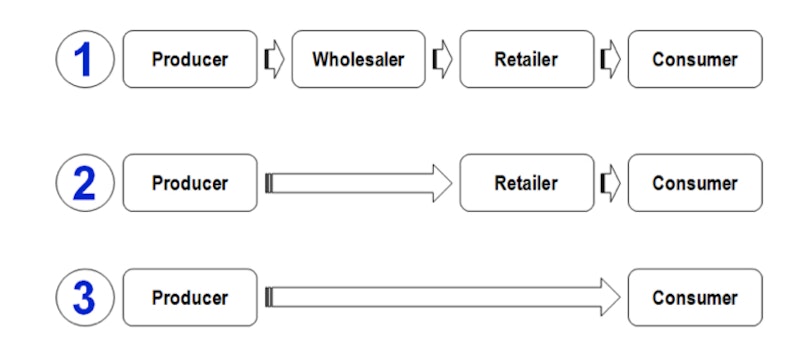Study Notes
Distribution Channels
- Level:
- GCSE, AS
- Board:
- AQA, Edexcel, OCR, IB
Last updated 22 Mar 2021
The main function of a distribution channel is to provide a link between production and consumption. A distribution channel can be very simple, with just two layers (producer and consumer). A distribution channel can also be very complicated, with several levels.
Each layer of marketing intermediaries that performs some work in bringing the product to its final buyer is a "channel level". The figure below shows some examples of channel levels for consumer marketing channels:

In the figure above, the first two channels are "indirect-marketing channels".
Channel 1 contains two intermediary levels - a wholesaler and a retailer. A wholesaler typically buys and stores large quantities of several producers' goods and then breaks into the bulk deliveries to supply retailers with smaller quantities. For small retailers with limited order quantities, the use of wholesalers makes economic sense. This arrangement tends to work best where the retail channel is fragmented - i.e. not dominated by a small number of large, powerful retailers who have an incentive to cut out the wholesaler. A good example of this channel arrangement in the UK is the distribution of drugs.
Channel 2 contains one intermediary. In consumer markets, this is typically a retailer. The consumer electrical goods market in the UK is typical of this arrangement whereby producers such as Sony, Panasonic, Canon etc. sell their goods directly to large retailers and e-tailers such as Comet, Tesco and Amazon which then sell onto the final consumers.
Channel 3 is called a "direct-marketing" channel, since it has no intermediary levels. In this case the manufacturer sells directly to customers. An example of a direct marketing channel would be a factory outlet store. Many holiday companies also market direct to consumers, bypassing a traditional retail intermediary - the travel agent.
What factors should be taken into account in choosing the best distribution channel? Here is a summary:
Nature of the product
Perishable/fragile? A product with a short-life
Technical/complex? Complex products are often sold by specialist distributors or agents
Customised? A direct distribution approach often works best for a product that the end consumer wants providing to a distinct specification
Type of product – e.g. convenience, shopping, speciality
Desired image for the product – if intermediaries are to be used, then it is essential that those chosen are suitable and relevant for the product.
The market
Is it geographically spread?
Does it involve selling overseas (see further below)
The extent and nature of the competition – which distribution channels and intermediaries do competitors use?
The business
Size and scope – e.g. can it afford an in-house sales force?
Marketing objectives – revenue or profit maximisation?
Does it have established distribution network or does it need to extend its distribution option
How much control does it want over distribution? The longer the channel, the less control is available
Legal issues
Are there limitations on sale?
What are the risks if an intermediary sells the product to an inappropriate customer?
You might also like

Startups, Technological Change and the Fast Food Market
21st November 2015

E-commerce, Retailers and the Age of Disruption
4th September 2015

River Island launches Click and (don't) Collect!
29th November 2015

How Technology is Transforming the Delivery Business
14th December 2015

Meet the entrepreneur who is allergic to bureaucracy
27th July 2017
Technological Change - the Retail Disruptors
10th October 2017
The future of shopping: what's in store?
20th March 2021